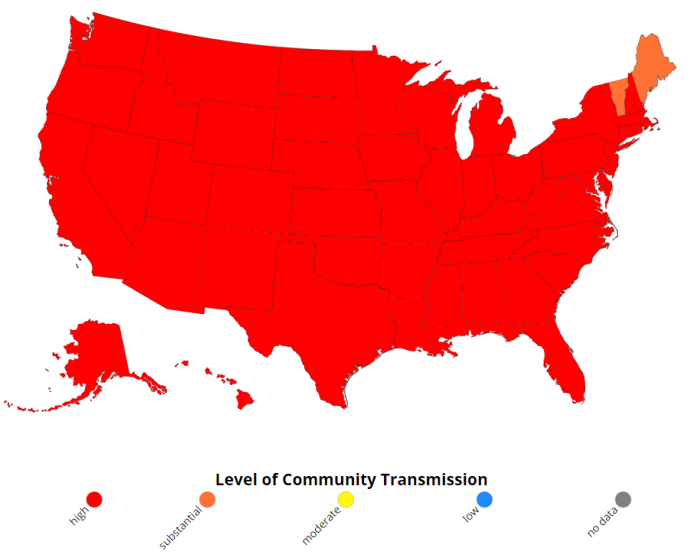Boston – With the CDC reporting that all but two of the 50 states are now at high levels of community transmission, let’s review the health policy responses and the bearish or bullish developments related to the COVID-19 pandemic for the third week of August.
All U.S. states except Maine and Vermont at high levels of community transmission

Source: Centers for Disease Control (CDC) as of August 18, 2021. Level of Community Transmission is based on the number of cases in the last 7 days per 100,000 population and the number of tests in the last 7 days that have a positive result.
Health policy responses
- The New York Times reported that Israel — one of the world’s most vaccinated countries — has a fourth wave of nearly the same magnitude as the two previous waves. An Israeli public health expert said, “We now understand that the vaccines are not enough.”
- Germany named the U.S., Israel and Turkey as high-risk COVID countries. Travelers must quarantine for 10 days unless they can show proof of vaccination.
- New Zealand entered a three-day nationwide lockdown after one local COVID-19 case — the first confirmed community transmission in 170 days. Similarly, Australia’s capital Canberra was ordered into a seven-day lockdown after a single COVID case was detected.
- Russia reported more than 800 daily COVID deaths in August after the record of 799 deaths was reported on four separate days in July.
- The Biden administration is likely to recommend that most Americans should receive a booster shot eight months after receiving their second dose of the vaccine.
- CBS News reported that unvaccinated workers could end up paying $50 more for health insurance — per paycheck.
Bearish virus developments
- A large study found that Pfizer’s COVID-19 vaccines are less effective against Delta and that efficacy wanes over time. According to Bloomberg, we don’t have data yet to show how much the vaccines continue to protect against hospitalizations and severe cases of COVID.
- An Oxford epidemiologist explained that herd immunity is not possible while the Delta variant is spreading.
- U.S. children hospitalized with COVID-19 hit a record 1,900, accounting for about 2.4% of the nation’s hospitalized COVID patients.
- The U.S. has significantly more hospitalizations per million people than other countries that are experiencing a Delta variant wave, with one in five intensive care units reaching or exceeding 95% of capacity.
- Florida set a weekly record for the number of new COVID-19 cases and the state’s test positivity rate is nearly 32%. In Tampa, over 10,000 students and staff in the nation’s seventh-largest school district are in quarantine or isolation this week — up from 6,000 just two days earlier.
Bullish virus developments
- The third Pfizer dose is 86% effective in those over 60 years old, according to an Israeli health insurer.
- There may be some slowing of U.S. new case growth.
- A Canadian-led trial found that an inexpensive anti-depressant could be the best COVID treatment yet: Patients taking fluvoxamine had a 30% lower chance of ending up in the hospital.
- Prior vaccination for Measles-Mumps-Rubella (MMR) or Tetanus-Diphtheria-Pertussis (Tdap) induces a T-cell response that overlaps with SARS-Cov-2 and appears to offer around 20% to 30% protection from severe COVID-19, according to a new study.
- While more than 200 people got COVID-19 at Lollapalooza, 88% of the 385,000 who attended were estimated to be vaccinated, so it turned out not to be a super-spreader event.
Economic developments
- New Zealand’s central bank delayed a planned interest rate rise on August 18 after the nation went into lockdown.
- Data for the last seven days show European commercial flights down 30% versus 2019, the best since the pandemic began, but one travel app reports a 33% increase in people buying cancelable tickets since July.
Source of all data: Eaton Vance Research as of August 19, 2021 unless otherwise specified.
This material is presented for informational and illustrative purposes only. This material should not be construed as investment advice, a recommendation to purchase or sell specific securities, or to adopt any particular investment strategy; it has been prepared on the basis of publicly available information, internally developed data and other third-party sources believed to be reliable. However, no assurances are provided regarding the reliability of such information and Eaton Vance has not sought to independently verify information taken from public and third-party sources.

